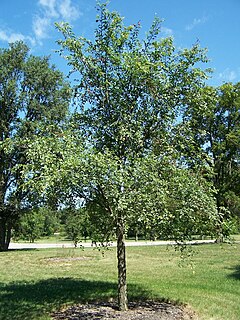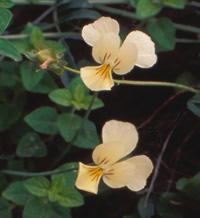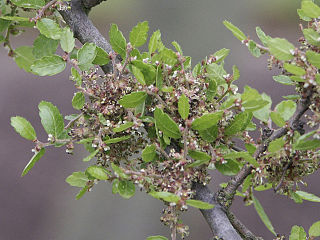
Zelkova is a genus of six species of deciduous trees in the elm family Ulmaceae, native to southern Europe, and southwest and eastern Asia. They vary in size from shrubs to large trees up to 35 m (115 ft) tall. The bark is smooth, dark brown. Unlike the elms, the branchlets are never corky or winged. The leaves are alternate, with serrated margins, and a symmetrical base to the leaf blade. The leaves are in two distinct rows; they have pinnate venation and each vein extends to the leaf margin, where it terminates in a tooth. There are two stipules at each node, though these are caducous, leaving a pair of scars at the leaf base. Zelkova is polygamous. Staminate flowers are clustered in the lower leaf axils of young branchlets; the perianth is campanulate, with four to six lobes, and the stamens are short. Pistillate and hermaphrodite flowers are solitary, or rarely in clusters of two to four, in the upper leaf axils of young branchlets. The fruit is a dry, nut-like drupe with a dorsal keel, produced singly in the leaf axils. The perianth and stigma are persistent.

Pinus nigra, the Austrian pine or black pine, is a moderately variable species of pine, occurring across Southern Europe from the Iberian Peninsula to the eastern Mediterranean, on the Anatolian peninsula of Turkey, Corsica and Cyprus, as well as Crimea and in the high mountains of Northwest Africa.

Ulmus chenmouiW. C. Cheng, commonly known as the Chenmou, or Langya Mountain elm, is a small deciduous tree from the more temperate provinces of Anhui and Jiangsu in eastern China, where it is found at elevations below 200 m on the Langya Shan and Baohua Shan mountains. The tree was unknown in the West until 1979, when seeds were sent from Beijing to the De Dorschkamp research institute at Wageningen in the Netherlands.

Ulmus gausseniiW. C. Cheng, the Anhui, or hairy, elm, is a medium size deciduous tree whose natural range is restricted to the valleys of the Langya limestone mountains of Chu Xian in Anhui Province, eastern China. The tree was most commonly found on the flood plains, indicating a tolerance of periodic inundation. However, U. gaussenii is now possibly the rarest and most endangered elm species, with only approximately 30 trees known to survive in the wild in 2009.

Juniperus phoenicea, the Phoenicean juniper or Arâr, is a juniper found throughout the Mediterranean region.

Zelkova carpinifolia, known as Caucasian zelkova, Caucasian elm or just zelkova, is a species of Zelkova, native to the Caucasus, Kaçkar, and Alborz mountains in the extreme southeast of Europe and southwest Asia.

Chtenopteryx sicula, also known as the comb-finned squid or toothed-fin squid, is a species of squid native to at least the Mediterranean Sea. It is characterised by several distinct morphological features: ocular photophores are present but visceral photophores are absent, arm suckers are arranged in at least 4 series distally, and club suckers are borne in more than 8 series.

Hieracium lucidum, or Sicilian sparviere, is a flowering plant in the family Asteraceae. It is very similar to Hieracium cophanense. Hieracium lucidum is a perennial herb that prefers the northern slopes of chalky seaside cliffs exposed to wet winds, including sites rich in nitrates from sea bird droppings. Unlike most other hawkweeds, this species reproduces only from seeds.

Petagnaea gussonei is a species of flowering plant in the family Apiaceae, and the only species in the genus Petagnaea. It is named after Neapolitan botanist Vincenzo Petagna (1734-1810). It is found only in Sicily, in Mediterranean-type shrubby vegetation, and is threatened by habitat loss.

The Cape mountain toad or Rose's mountain toad is a species of toad in the family Bufonidae. Other common names include Rose's mountain toadlet, striped mountain toad, Rose's toad, and Muizenberg Cape toad. It is endemic to South Africa, where its natural habitat is Mediterranean-type shrubby vegetation known as fynbos. It is threatened by habitat loss.

The Sicilian shrew is a species of mammal in the family Soricidae. It is found in Sicily (Italy) and Gozo (Malta). Its natural habitat is temperate shrubland.

Ribes sardoum, commonly called Sardinian currant, is a species of plant in the gooseberry family. It is endemic to Italy, found only on the island of Sardinia.

Silene hicesiae is a species of plant in the family Caryophyllaceae. It is endemic to Panarea and Alicudi, which form part of the Aeolian archipelago, a commune of Sicily, Italy. Its natural habitats are Mediterranean-type shrubby vegetation and rocky areas. It is threatened by habitat loss.

Viola ucriana is a species of plant in the Violaceae family. It is a violet that is endemic to Sicily in Italy, where its known in Italian as Viola di Ucria.

Zelkova abelicea is a species of tree in the family Ulmaceae. It is referred to by the common names Cretan zelkova, and on Crete proper as abelitsia (αμπελιτσιά). It is endemic to Crete. It is found in small numbers and is classified as Vulnerable on the IUCN red list of endangered species.

The Mediterranean painted frog or simply painted frog is a species of frog in the family Alytidae.

The Orto Botanico dell'Università di Catania, also known as the Hortus Botanicus Catinensis, is a botanical garden in Catania, Sicily, southern Italy. It is operated by the University of Catania botany department. This institution is a member of BGCI, with international identification code CAT.

The flora of Italy is all the plant life present in the territory of the Italian Republic. The flora of Italy was traditionally estimated to comprise about 5,500 vascular plant species. However, as of 2019, 7,672 species are recorded in the second edition of the flora of Italy and in its digital archives Digital flora of Italy. In particular, 7,031 are autochthonous and 641 are non native species widely naturalized since more than three decades. Additionally, further 468 exotic species have been recorded as adventitious or naturalized in more recent times.

Galium litorale is a rare species of bedstraw in the Rubiaceae family. It is endemic to the island of Sicily in the Mediterranean Sea. In Italian it is known as caglio costiero.

Solitudo is an extinct genus of tortoise that was found during the Pliocene and Pleistocene on the Mediterranean islands of Menorca, Malta and Sicily. The genus includes three described species, Solitudo robusta, Solitudo gymnesica and Solitudo sicula as well as a likely fourth, undescribed species from Monte Pellegrino in Sicily. Solitudo sicula, the youngest of the species, died out approximately 12.5 thousand years BP. The largest species, Solitudo gymnesica, has been estimated to have reached a carapace length of 1.1–1.3 m (3.6–4.3 ft).





















